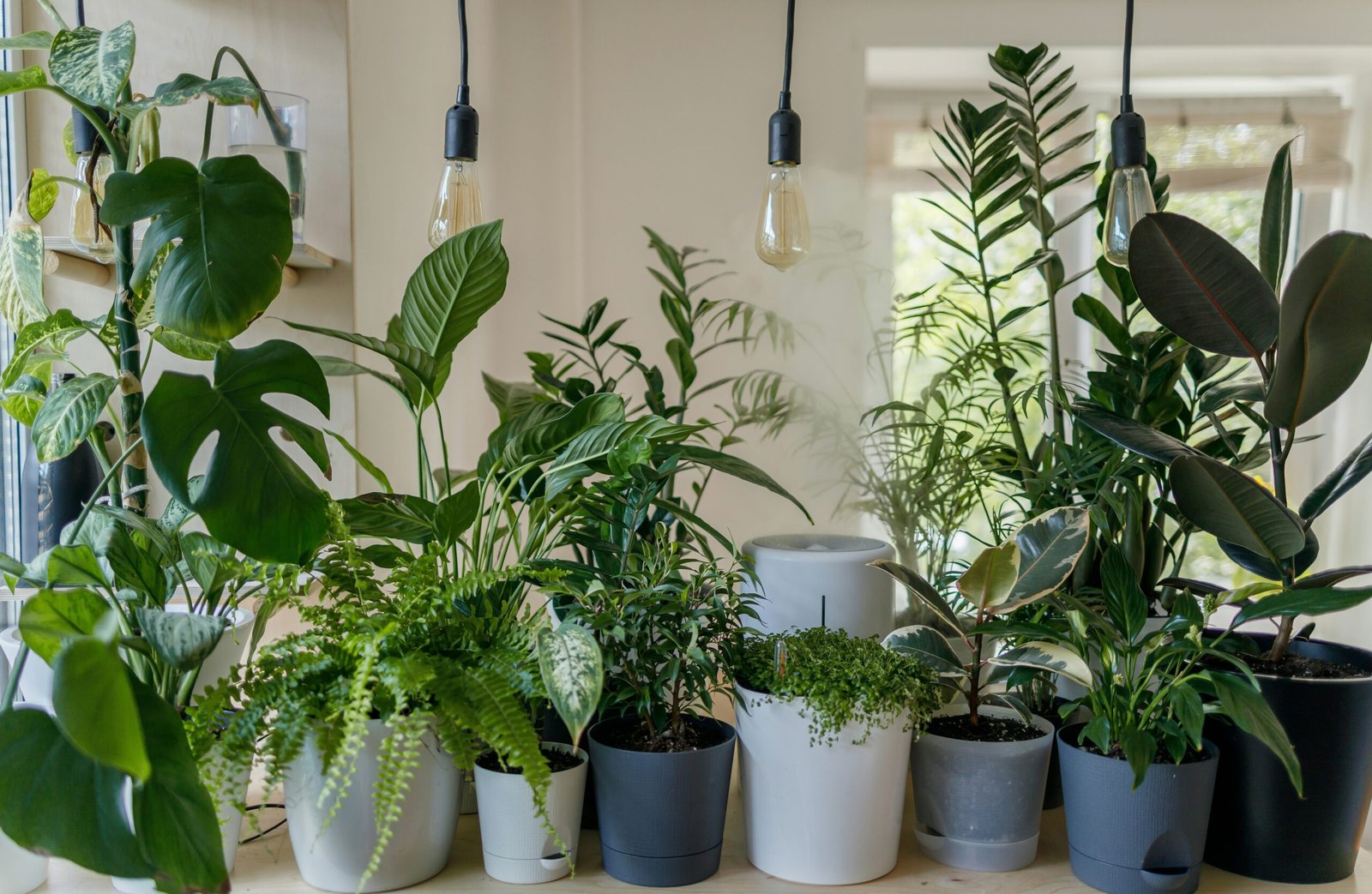Want to transform your bedroom into a calmer, greener retreat using plants?
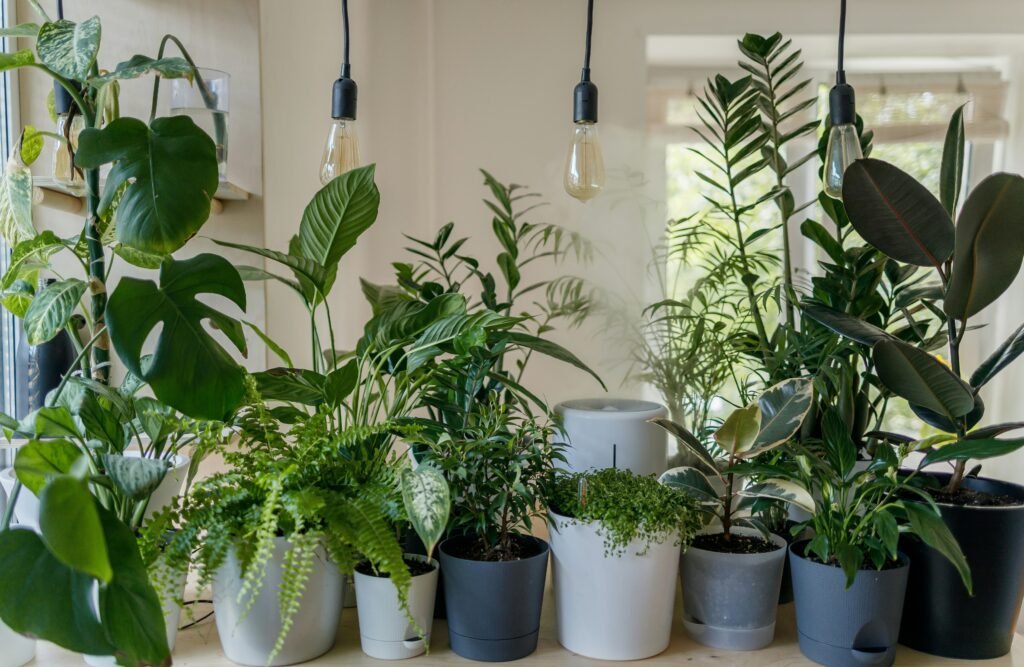
How Can I Decorate My Bedroom With Plants?
You can make your bedroom feel more inviting, healthful, and stylish by adding plants. This article guides you through choosing the right plants, arranging them for aesthetic and functional benefit, and maintaining them so your bedroom remains a restorative sanctuary.
Why Use Plants in Your Bedroom?
Plants do more than look pretty — they can improve air quality, add texture and color, and influence mood. You’ll notice a psychological lift from greenery, and with the right choices, plants can even help with humidity and air purification.
Benefits for your health and mood
Plants release oxygen and some species help remove common indoor pollutants. Beyond air chemistry, having plants nearby reduces stress and supports better concentration and sleep routines.
Benefits for your room’s aesthetics
Plants introduce natural shapes and hues that soften lines and create focal points. You can use plants to emphasize certain areas, conceal flaws, or make small rooms feel deeper and more layered.
Planning Your Plant Layout
Before you buy anything, consider the layout of your bedroom. Measure light levels, available floor and shelf space, and think about how often you want to care for plants.
Evaluate light and space
Look at where sunlight falls through the day. South- or west-facing windows get the most light; north- or east-facing windows receive softer, lower light. Take note of floor space, bedside tables, dressers, and potential hanging locations.
Decide on your plant’s role
Do you want plants to be statement pieces, subtle accents, or functional devices (like a hanging plant near the bed)? Your role choice affects size, type, and placement.
Choosing the Right Plants for Your Bedroom
Selecting species that match your light, time for care, and aesthetic keeps your plants thriving. Some plants are low-maintenance, while others need more attention.
Low-light tolerant plants
If your room has limited natural light, choose species that tolerate shade. These plants are forgiving and easier for beginners to keep alive.
Bright-light plants
For sunny rooms, pick plants that crave strong light and will reward you with lush growth and flowering.
Pet-friendly options
If you share the space with pets, prioritize non-toxic species and keep potentially harmful plants out of reach.
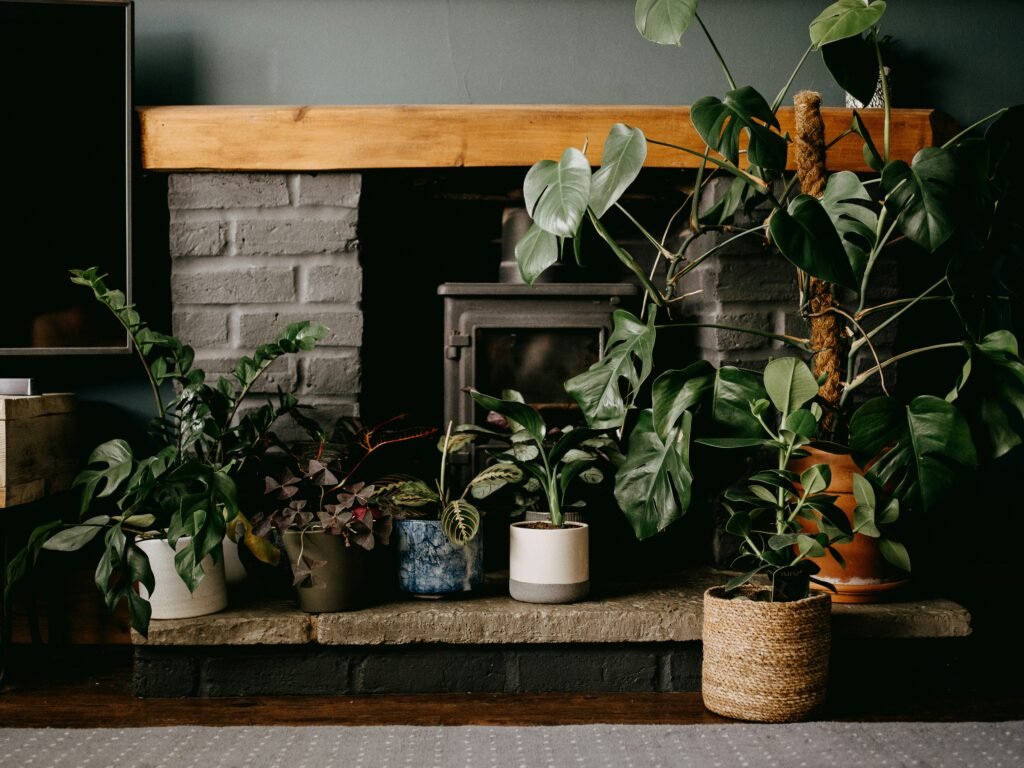
Table: Plant Comparison at a Glance
This table helps you match typical bedroom conditions to appropriate plants. Light key: Low = low/filtered light; Medium = bright indirect; High = direct sun. Water key: Low = infrequent; Medium = weekly; High = regular/2–3 times per week. Pet-safe indicates common listings from ASPCA but always check species-specific guidance.
| Plant | Light | Water | Difficulty | Typical Size | Pet-safe? |
|---|---|---|---|---|---|
| Snake Plant (Sansevieria) | Low–Medium | Low | Easy | 1–4 ft | No (mildly toxic) |
| ZZ Plant (Zamioculcas zamiifolia) | Low–Medium | Low | Easy | 1–3 ft | No (toxic) |
| Pothos (Epipremnum aureum) | Low–High | Medium | Easy | Vines up to 10 ft | No (toxic) |
| Spider Plant (Chlorophytum comosum) | Low–Medium | Medium | Easy | 1–2 ft, pups | Yes |
| Peace Lily (Spathiphyllum) | Low–Medium | Medium–High | Medium | 1–3 ft | No (toxic) |
| Rubber Plant (Ficus elastica) | Medium–High | Medium | Medium | 4–8 ft | No (toxic) |
| English Ivy (Hedera helix) | Medium | Medium | Medium | Vining | No (toxic) |
| Philodendron (various) | Low–Medium | Medium | Easy | Vines or upright 1–6 ft | Some toxic |
| Boston Fern (Nephrolepis exaltata) | Medium | High | Medium | 1–3 ft | Yes |
| Haworthia / Succulents | High | Low | Easy | Small 2–6 in | Yes (some) |
| Aloe Vera | High | Low | Easy | 1–2 ft | No (toxic) |
| Calathea / Prayer Plant | Low–Medium | Medium | Medium | 1–3 ft | Yes |
Note: Toxicity varies by species and part of the plant. Confirm species-specific safety if you have pets or small children.
How to Match Plants to Your Light Conditions
Choosing plants by light level is essential. Matching plants to available light reduces frustration and encourages vigorous growth.
Low light strategies
Place shade-tolerant plants near north-facing windows or away from windows on shelves. For rooms with no windows, you can use artificial grow lights to supplement.
Medium to bright indirect light
Many popular indoor plants prefer bright, indirect light — near an east- or west-facing window with sheer curtains or a few feet away from a south-facing window.
Direct sun plants
Succulents, cacti, and some herbs will do well on a sunny windowsill. Rotate them occasionally to promote even growth.
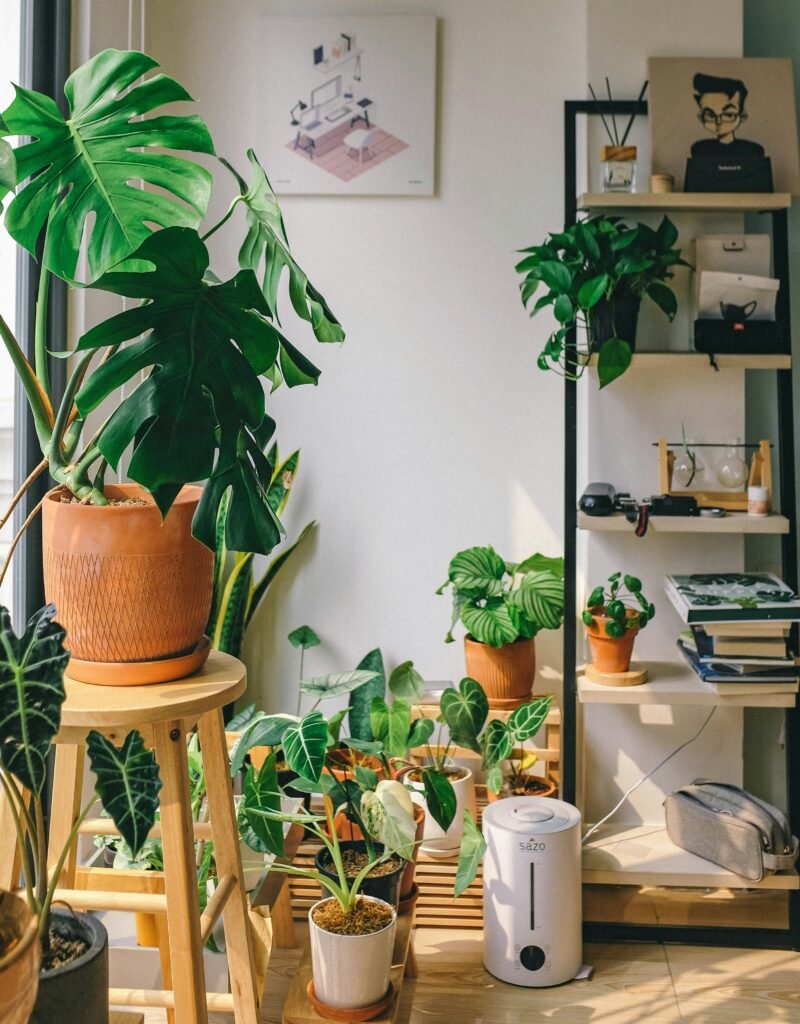
Pots, Planters, and Styling Choices
The containers you choose influence aesthetics, drainage, and root health. Consider materials, colors, and shapes that fit your room’s style.
Choosing pots with proper drainage
Always prefer pots with drainage holes or use a pot with a liner for drainage to prevent root rot. You can use a decorative cachepot over a functional container to keep looks tidy.
Material pros and cons
- Terracotta: breathable and attractive but dries quickly.
- Ceramic: glazed ceramic is moisture-retentive and stylish.
- Plastic: lightweight and inexpensive; retains moisture longer.
- Metal: modern aesthetic but can heat up near sunny windows.
- Woven baskets: cozy and textural but use liners to protect from water damage.
Table: Pot material comparison
| Material | Moisture retention | Weight | Style notes | Best for |
|---|---|---|---|---|
| Terracotta | Low | Medium–Heavy | Earthy, rustic | Succulents, plants needing drier soil |
| Glazed Ceramic | Medium–High | Heavy | Colorful, polished | Tropical plants, display pieces |
| Plastic | High | Light | Budget-friendly, practical | Beginner plants, hanging pots |
| Metal | Variable | Medium–Heavy | Modern, sleek | Statement pieces (avoid in direct sun) |
| Wicker/Basket | Variable | Light | Cozy, boho | Use as cover for plastic liner pots |
Styling Ideas for Different Bedroom Sizes
Plant styling depends on how much space you have. You can create impact in tiny rooms or coordinate a layered look in larger spaces.
Small bedrooms
Use vertical space: hanging planters, wall-mounted planters, narrow floor stands, and plant ladders. Choose smaller or trailing species to prevent crowding.
Medium bedrooms
Create groupings on dressers, bedside tables, and window sills. Mix heights and textures to form a mini indoor garden without overwhelming surfaces.
Large bedrooms
Consider larger floor plants such as rubber plants or fiddle-leaf figs to anchor corners. Combine with a cluster of smaller plants to create focal points and soften large empty spaces.
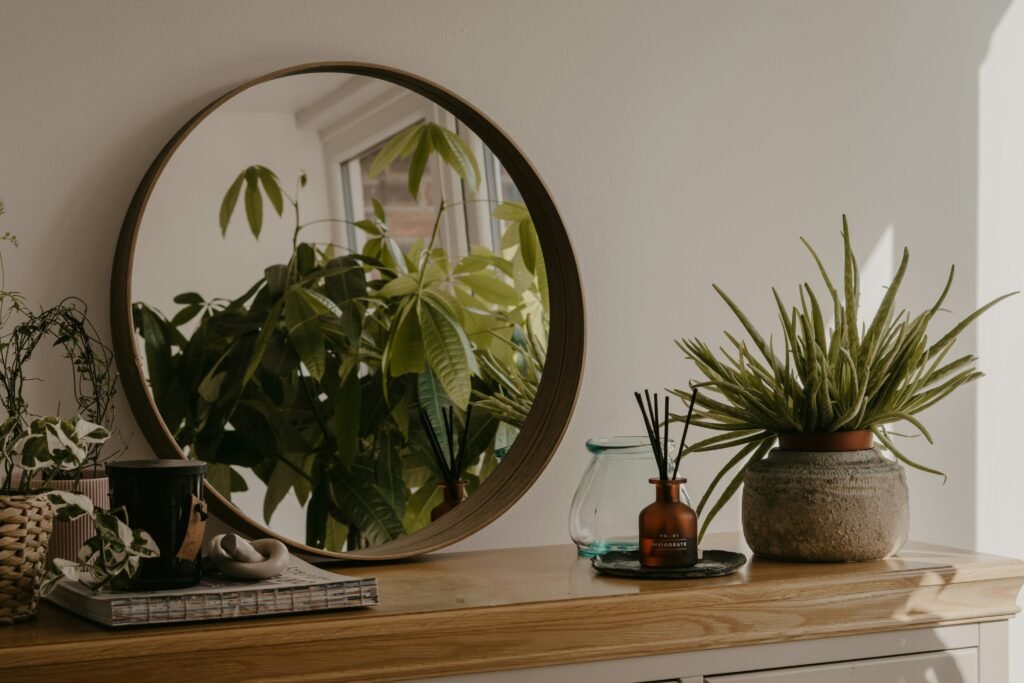
Where to Place Plants in Your Bedroom
Placement affects light access and the overall vibe. Strategic placement can also support better sleep and functionality.
Bedside plants
Smaller plants on bedside tables add softness and visual interest. Choose species with low pollen and scent if you’re sensitive.
Windowsills and shelves
Windowsills are natural spots for sun-loving plants. Shelves let you layer trailing plants and create living walls without using floor space.
Hanging and wall-mounted options
Hanging planters free up surfaces and create vertical movement. Wall-mounted planters can form green art installations.
Floor plants and corners
Tall floor plants anchor corners and create natural dividers. Position them where they won’t obstruct walkways.
Styling by Design Aesthetic
Match your plant choices and containers to the overall room style to maintain cohesion.
Minimalist and modern
Pick sculptural plants with clean lines like snake plants or ZZ plants. Use monochrome pots or sleek planters in black, white, or matte finishes.
Bohemian and eclectic
Mix textures, macramé hangers, and woven baskets. Combine an array of trailing and bushy plants to create a relaxed abundance.
Scandinavian and cozy
Opt for neutral-colored pots, wooden stands, and a few well-placed plants like rubber plants or baby’s tears. Keep arrangements light and airy.
Tropical and lush
Choose broad-leaf plants (e.g., monstera, philodendron) and pair them with rattan furniture or botanical prints for a high-impact, green look.

Practical Care: Watering, Feeding, and Potting
Consistent care ensures that plants remain healthy and attractive in your bedroom.
Watering basics
Water according to each plant’s needs—overwatering is a common mistake. Check soil moisture with your finger or a moisture meter; most plants prefer the top inch or two of soil to dry out before the next watering.
Fertilizing and feeding
Feed plants during their active growing seasons (spring and summer) with a balanced houseplant fertilizer. Reduce or stop feeding in fall and winter when growth slows.
Repotting and root health
Repot every 1–3 years or when roots become pot-bound. Choose a pot that’s 1–2 inches larger in diameter than the current one for most houseplants.
Soil and Potting Mixes
Using the right potting mix supports drainage and root development.
Standard potting mix
A general-purpose indoor potting mix is suitable for many plants. It retains moisture yet drains better than garden soil.
Special mixes for succulents or orchids
Succulents and cacti require gritty, fast-draining mixes. Orchids need chunkier, bark-based mixes for air circulation around roots.
DIY mixes
Mix potting soil with perlite or pumice for improved drainage. For succulents: 3 parts potting mix + 2 parts coarse sand or pumice.
Using Lighting to Support Plant Health
Artificial lights can supplement natural light when needed.
Grow lights: when and how to use them
If your bedroom lacks sufficient sunlight, use LED grow lights. Position them above plants and follow manufacturer instructions for duration. Most plants thrive with 10–14 hours of supplemental light if natural light is minimal.
Types of grow lights
LEDs are energy-efficient and produce lower heat. Fluorescent tubes are affordable for shorter setups. Choose full-spectrum lights for best results.
Dealing with Pests and Common Problems
Recognize and treat common houseplant problems early to prevent spread.
Common pests
Look out for spider mites, aphids, mealybugs, and scale. Wipe leaves, use insecticidal soap, or isolate affected plants to control infestations.
Signs of overwatering and underwatering
Yellowing leaves and mushy stems typically indicate overwatering. Brown, crispy edges and drooping suggest underwatering. Adjust watering frequency accordingly.
Leaf care and pruning
Wipe dust off leaves to improve photosynthesis. Remove dead or yellowing leaves and trim leggy growth to maintain shape.
Safety Considerations: Pets and Allergies
If you share your bedroom with pets or have allergies, choose plants carefully and place them strategically.
Pet safety strategies
Keep toxic plants out of reach or choose pet-safe species. Consider using elevated stands or hanging baskets for plants that are appealing to curious pets.
Allergy considerations
Avoid heavily flowering plants or those that release lots of pollen if you’re sensitive. Also wash bedding and vacuum regularly to reduce airborne allergens from soil and plant dust.
Seasonal Care and Rotation
Adjust care across seasons to match plant needs and indoor changes.
Winter care
Most plants grow slower in winter. Water less frequently, reduce fertilizing, and keep plants away from drafts or heaters that dry the air.
Summer care
Increase watering during hot months and consider misting humidity-loving plants. Rotate plants occasionally to ensure even sun exposure.
Creative DIY Plant Decor Projects
You can personalize your plant decor with simple DIY projects that add charm and uniqueness to your bedroom.
Macramé hangers and plant shelves
Make or buy macramé hangers for a boho look. Build floating shelves to create a layered plant display on a wall.
Painted pots and terrariums
Customize plain pots with paint or decoupage. Small glass terrariums can house humidity-loving plants like ferns and mosses.
Plant frames and living walls
Create a living frame for small succulents or a large grid of small pots to form a green wall. These can act like living artwork above a headboard.
Budget-Friendly Planting Tips
You don’t need to spend much to create a green bedroom. Start small and expand gradually.
Propagation and cuttings
Propagate from cuttings of friends’ plants, or split an existing plant. Many common species like pothos, philodendron, and spider plants propagate easily in water.
Shop smart
Buy smaller plants and repot them into nice containers, or look for sales at nurseries and garden centers. Local plant swaps and online groups can be good sources for affordable plants.
Mistakes to Avoid
Avoid a few common errors that can undo your decorating efforts or harm your plants.
Overcrowding
Too many plants in a small space can limit airflow and lead to pest or disease problems. Give plants room to grow.
Ignoring light needs
Putting shade plants in direct sun or sun lovers in dark corners leads to poor growth and frustration. Match plants to conditions.
Overwatering
This is the single most common cause of houseplant death. Check soil moisture before watering and ensure good drainage.
Frequently Asked Questions
Answering typical concerns helps you make better decisions about plant decoration.
Can plants help you sleep?
Some plants may improve perceived air quality and create a calming environment that supports better sleep. Avoid heavily scented or flowering species at night if you’re sensitive to odors.
How many plants should I have in my bedroom?
There’s no fixed number. A few well-placed plants are often more effective than cluttered preponderance. Aim for balance with other decor.
Are low-light plants really low maintenance?
Low-light plants often need less frequent watering but still require occasional repotting and attention to pests and dust.
Final Styling Checklist
A short checklist helps you finish the setup and maintain it.
- Assess light and measure available spaces.
- Select plants suited to the light and your care ability.
- Choose pots with adequate drainage and appropriate size.
- Plan placement: bedside, floor, hanging, or shelves.
- Group plants with similar needs together for easier care.
- Water and fertilize according to species-specific schedules.
- Rotate plants for even light exposure and check for pests regularly.
- Adjust care seasonally and propagate to expand affordably.
Final Thoughts
You can create a bedroom that feels restful, healthy, and personalized by carefully choosing and arranging plants. Start with a few easy species, learn their needs, and gradually refine your styling and layout. Your green bedroom will reward you with a calmer atmosphere and a daily connection to nature.
